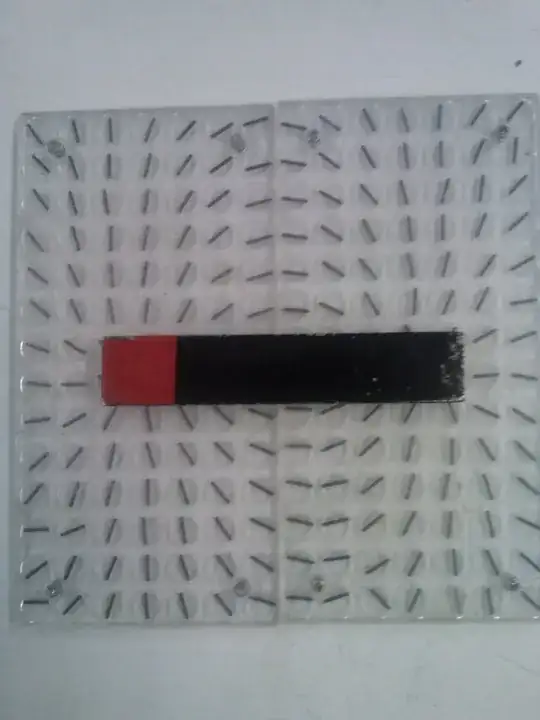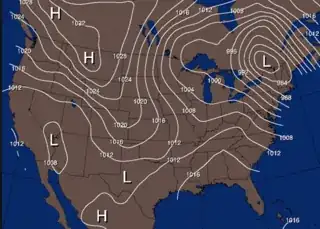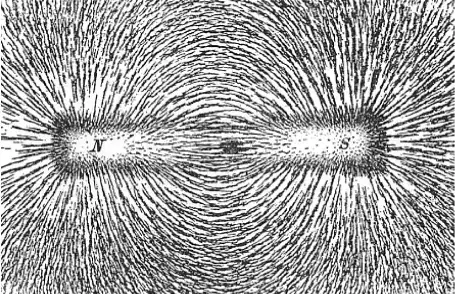Obviously the iron filings can be seen aligning themselves along the virtual magnetic field lines produced by the permanent magnet, the virtual magnetic field line is made of electromagnetic field due to the alignment of electrons in the magnet but why the patterns, why lines? Do these lines have thickness? Are they due to interference pattern?
7 Answers
Here's a map of the barometric pressure in the United States.
The map contains isobars, which are lines of constant pressure. These are constructed by starting from an arbitrary point, and following the direction where the pressure doesn't change.
Isobars don't "exist", in the sense that there isn't literally a big white line in the sky hovering over New York City at this moment. Isobars aren't made of anything, and whether or not an isobar goes through a point on a map is decided entirely by how the map maker decided to draw them. But they help you visualize pressure, which is very real.
When people say that magnetic field lines don't "exist", they mean they're like isobars: a completely arbitrary visualization tool that doesn't exist outside of diagrams. But like pressure, the magnetic field itself is as real as it gets. Iron filings follow its direction.
- 107,105
Individual iron filings will align their long dimension with the magnetic field. But then they will also feel the induced magnetization in other iron particles nearby, and they will tend to move toward each other till their points touch.
This is what creates the strings of iron particles. When the needles cannot move from their site, one does not get lines. 
That does look like there are real lines, doesn't it?
It's because each iron filing becomes its own magnet which affects the others.
Notice how they're all crowded together close to the ends of the magnet, and then there's a region where they're thin, and then they get closer together farther away?
I think that's because close up, the magnetic field of the bar magnet is very strong and is the most important thing. But a little distance from there, the iron filings are each strong magnets and they repel each other to the sides while they strongly attract each other at their ends. If you could cut the bar magnet in half the long way without making enough heat to destroy its magnetic fields, the halves would spring apart because they repel each other. The metal magnet holds itself together too strongly to let that happen. But if you cut it in half the short way, the two halves would cling to each other.
Farther away the iron filing magnets are weaker and so they don't repel each other as much and the lines get closer.
- 3,146
When we say that magnetic field lines don't exist we mean that there is no physical form of them. Magnetic field lines just represent the direction of force which a ferromagnetic substance like iron would experience in the vicinity of a magnet (the pattern formed by iron filings).
The specific lines or pattern is formed because that the the actual direction of force iron filing would experience when placed freely in the environment
- 327
- 2
- 13
The iron filings themselves repel each other and create a pattern that can be observed visually as lines.
Liquid metals create mountains that end with peaks as the active forces dissipate, so you can see the concentration is highest nearest the origin.
- 39
Magnetic field lines show the direction of force a magnetic mono-pole would experience if it were free to move under the influence of a magnet, but unfortunately, we all know that mono-poles are just a thing of imagination and don't exist in reality. This is given by Gauss' law for magnetism which states
$$\oint \mathbf B\cdot\text d\mathbf s=0$$
Whenever iron filings are scattered around a magnet, they become magnetized and (for a short time) also behave as tiny little magnetic dipoles. Those little magnets can just rotate a bit and align themselves with the field because they can't move and stick to the bar since the experiment table offers some friction.
Now as more of the filings align themselves with the field generated by the adjacent filings, they form a continuous loop around the magnet and that gives us a very nice visual perception of how the magnetic field lines look like. Of course, the "field lines" don't exist in real life.
- 1,566
What is happening when iron filings form a "field line" pattern, is actually an energy minimisation process, somewhat akin to the reason that solar systems form out of rotating clouds of dust. Each individual iron particle becomes magnetised by the applied field, much more so than the surrounding medium. There are then forces acting on the adjacent iron particles which can be treated as lots of small magnets. The minimum energy configuration has the long axis of the particle lined up with the applied field, and particles grouped together into filaments which have roughly the same shape as the imaginary magnetic field lines.
The energy may not be fully minimized -- there is friction with the supporting paper to consider, and also the likelyhood that the pattern gets stuck in a local energy minimum rather than the global one.
You get some truly weird patterns if you use a ferromagnetic liquid and a magnet. (Actually, lots of really tiny more or less spherical ferromagnets suspended in oil).
- 700

